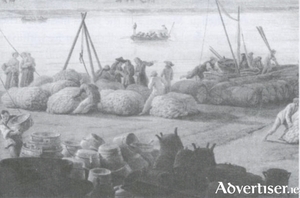Search Results for 'James Hardiman'
25 results found.
The Mayor of the Claddagh talk

The Claddagh fishing village was a unique settlement which developed outside the walls of medieval Galway which traditionally elected its own mayor, or king.
Hardiman’s description of The Claddagh

“The only occupation is fishing; they never trouble themselves with tillage; a milch cow and a potatoe garden are rare among them ------, then on shore they are principally employed in attending to, and repairing their boats, sails, rigging, cordage etc .., and in making, drying or repairing their nets and spillets, in which latter employment they are generally assisted by the women who spin hemp and yarn for the nets ....
‘What part of Galway is Ireland situated?’

By the 16th century Galway was a compact, well laid out town with handsome buildings. The wealth of the Tribal families, built up over decades of canny and adventurous trade, was reflected in their luxurious homes; fragments of which, in delicate carved limestone, remain around the old town.
St Augustine’s Well

James Hardiman, in his history of Galway, lists seven holy wells in Galway, St Bride’s in the eastern suburbs; St Anne’s towards the west of the town near the strand (on Whitestrand Avenue); another further along the shore (St Enda’s Barna?); St Bridget’s at the bottom of Red Earl’s Lane on Flood Street; St John the Baptist’s on Lough Athalia; one dedicated to the Blessed Virgin on Lough Athalia; and one dedicated to St Augustine on Lough Athalia. The last three were all above the high water mark, and on his 1818 map, Logan attributes all three to St Augustine. O’Donovan’s Ordnance Survey Letters refers to a stone with a cross cut out on each of these three wells.
Joe Young’s ‘Windy Waters’

James Hardiman, in his history of Galway, mentions a spring well that was reputedly 1,000 years old. He described it as “A Chalybeate spring of the same class as the celebrated Scarborough Waters, outside the East Gate was in great repute here. A spa house has been erected over it by a Mr. Eyre (who sailed with Columbus when America was discovered) and is much frequented.” Hardiman attributed to the tonic qualities of the water the numerous instances of longevity which he observed in the district.

